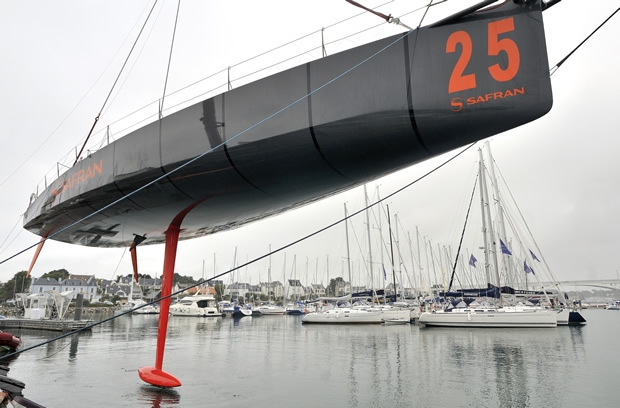
Marc Guillemot has been forced to retire after his keel failed. This may not be a big surprise to some.
It is not clear to me where the keel broke but it is clear that Marc's Keel was a revolutionary design and was probably a big risk. I am not sure how much they were able to test it but it was the first Open 60 Keel to be made of Titanium.
The keels on Open 60's are known as "kanting keels". This means they can be swung from side to side, pivoting at the hull. The can be swung as much as 40 degrees (it may be even more now). This serves the purpose of allowing them to get more righting moment or leverage on the power produced by the sails that tends to want to tip the boat over sideways (heeling). When sailing upwind and on a power reach this yields enormous additional speed. It is also a safety feature (when they don't fall off) because they can be used to right a turtled boat by kanting the keel one way or the other. In fact this is one of the seaworthiness tests that must be performed on all Open 60's that enter the Vendee Globe Ocean race.
So why Titanium? They are always looking for ways to lower the centre of gravity. The more weight that can be put in the bulb at the bottom of the keel the better the righting moment for the same overall weight. The more weight you push through the water, the more energy is required, so keeping the overall weight of the boat down is desirable and something for which designers and builders will go to extraordinary lengths to achieve in their quest for better performance. Sometimes they go too far and this is all part of the undertaking - to take these sort of calculated risks.
The original kanting keels were made from solid pieces of steel with the bulb bolted onto the bottom. They are essentially two pieces - a wing that extends about 15 ft below the hull and about 2 ft into the hull and the bulb. The bulb is often a chunk of lead. The strength is all in the steel wing and it has to be really strong to hold up the enormous bulb and especially so when the boat launches over large waves and crashes back down. The top of the keel wing sticks up inside the boat in a sealed box and has hydraulic rams on either side for pushing the keel to one side or the other, thus swinging the bulb to windward.
As the designers searched for advances in the keel technology they started to make hollow steel wings with a pattern of reinforcement inside - often with a steel eye beam down the center, ribs wielded to that and sheet metal wrapping the entire thing. The wielding of these structures is very tricky and even harder to inspect those wields after they are built because they are covered by the sheet metal. These hollow steel keels would then have the lead bulb bolted to the tip. By using a hollow wing more of the weight can go in the bulb where it is more efficient in producing greater righting moment which results in an ability to sail more powered up and thus faster!
Some have tried to use carbon in this hollow wing structure. There have been many keel failures with these hollow designs over the years. My Kiwi friend and Open 60 expert boat captain, Allan West, is a big fan of the solid steel wings. I have not done any surveys to see how many hollow keels have actually made it around the world without breaking but I think it is safe to say that all the top boats have some form of hollow keel whether steel or carbon or some combination. Some of the older boats still have the solid steel wing. O CANADA has a solid steel wing and I can tell you that I was glad of it in some of the monster seas we experienced coming back to New Zealand from Fiji in 2010. The jarring can be violent and it seems to me an easy trade off to sail with a slightly lighter bulb in order to have a reliable keel. The keel is one of those essential piece of gear to make it around right side up:)
Safaran was trying to take the development one step further with a hollow titanium keel. Titanium is lighter than steel but also very strong. I seem to recall that it does not bend as well as steel and tends to be slightly more brittle. Steel is more forgiving in this way but titanium is almost 1/2 the weight of steel (a rough guess) for the same strength. here is a posting about the properties of steel vs titanium for those who like to get technical http://answers.yahoo.com/question/index?qid=20100319171745AAOllge
So the bottom line is the score for new technology is 1 down ? to go. How many more technology failures will we see? Hard to say. That pre-race debate between the conservative Brits sailing old boats with more proven technology vs. some of the French guys with new stuff is starting to look like it will continue to be one of the themes of this race.
Stay tuned for more Vendee action as they set their kites and head south.
John
